Digital Meccano - the Stock Span Bridge
Posted: 18 December 2012 11:49
One of the things I love about Google Sketchup is the ability to model pretty much anything you care to measure up. Using some scale drawings I recreated a lesser-known bridge in use by the British Army in WW2.
Having been delving into Royal Engineers training manuals, I couldn't resist the urge to recreate some structures relevant to archive research and fieldwork I've been conducting of late.
We'll be looking at two types of bridge over two posts; the Stock Span Bridge and the Callender-Hamilton Bridge.
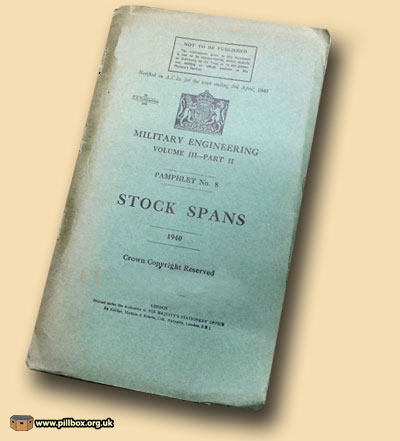
The Stock Span Bridge
The stock span bridge was intended for use in rear areas and was designed to do nothing more than provide the components to allow engineers to implement the basic concepts of bridging.
It was especially useful in spanning small gaps for which the use of more versatile and valuable bridges (such as the Callender-Hamilton) were deemed uneconomical.
Envisaged uses included road bridges over railway lines and spanning canal locks. These bridges were to be semi-permanent and not intended for use as assault bridges.
The 1940 manual on the subject tells us that stock spans were of four fixed lengths of 26, 32 (two types) and 37ft and were designed to carry loads of up to Class 30, i.e., 30 tons. One of the 32ft designs and the 37ft span used two-piece RSJs in their construction.
Components
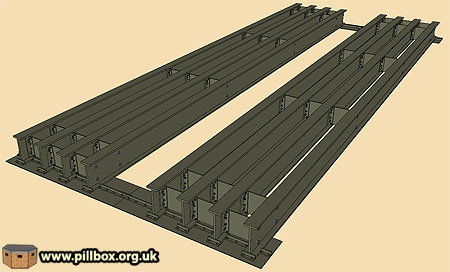
The idea of stock spans was that they were constructed from very basic materials such as rolled steel joists (RSJs) and rough timber, meaning that if a stock span were to be damaged or components lost for whatever reason, the shortage could be met by sourcing locally-available materials.
The stock span comprised eight RSJs bolted together with spacer plates in two groups of four, as shown in the graphic at right. A baseplate at each end provided an interface with the bank seats or abutments.
A timber decking was laid on top perpendicular to the RSJs. Two lengths of decking baulk were used; long and short. The short were the most numerous, interspersed at regular intervals by the long baulks.
These longer planks extended on both sides of the bridge and served as supports for a pedestrian gangway with handrails made of rope.
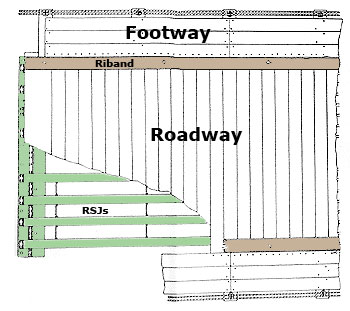
The 1941 general bridging manual states that the distance between the handrails on any bridge should be at least 10ft for the convenience of loaded camels!
The stock span catered for camels; the actual roadway itself was 10ft wide and was defined by a pair of ribands on each side.
These heavy-duty timbers served to ensure that vehicle wheels didn't stray off the bridge and they also held the decking baulks in place.
The (crumpled) fold-out cutaway diagram at right comes from the Stock Span manual and shows the general layout of the decking. I've coloured the RSJs and baseplate green and the ribands in brown for clarity. This and other plans in the manual were invaluable in allowing me to recreate the bridge.
The ribands were bolted through the long baulks and clamped fast to the top flange of the main RSJs. This held the long baulks in place, thus keeping the short baulks sandwiched between them with the ribands on top.
| Stock Span Components and Quantities | ||
|---|---|---|
| 1 | Short decking baulk | 32 |
| 2 | Long baulk with handrail stanchions | 6 |
| 3 | RSJ roadbearer | 8 |
| 4 | Riband (wheelguide/kerb) | 4 |
| 5 | Bridge seating plate | 2 |
| 6 | Spacer plate with angle brackets | 32 |
| 7 | Footway plank | 12 |
The specialist stock span manual includes detailed dimensions in the aforementioned diagrams, so it was logical for me to construct one of each of the parts and then build the bridge piece by piece.
Sketchup has a feature that allows you to create components which are reusable parts; simply make multiple copies of each and slide them together.
The table at right and image below list and illustrate the key components for the 26ft span.
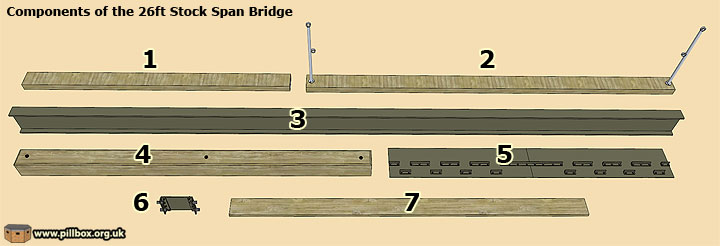
The finished bridge is seen below:
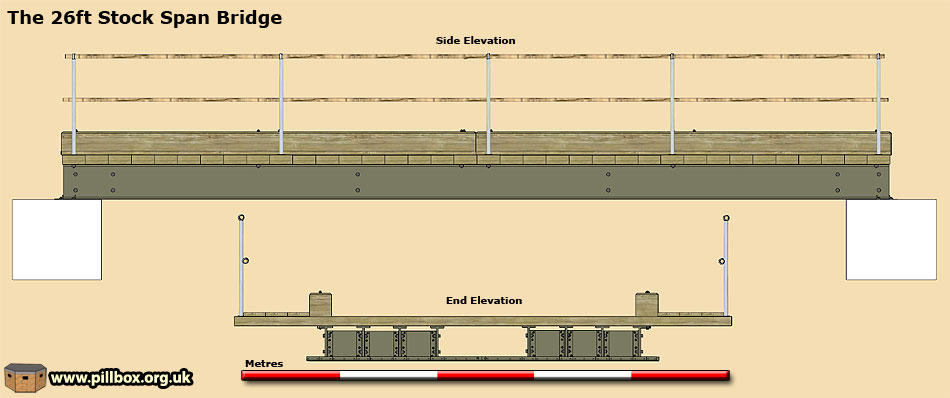
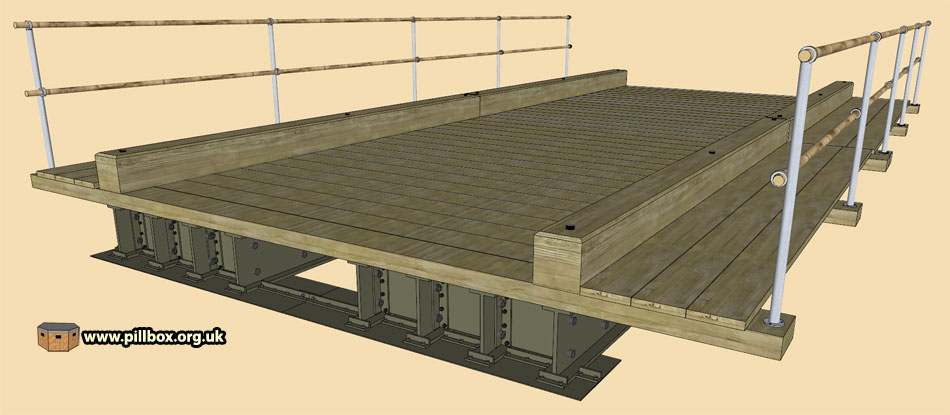
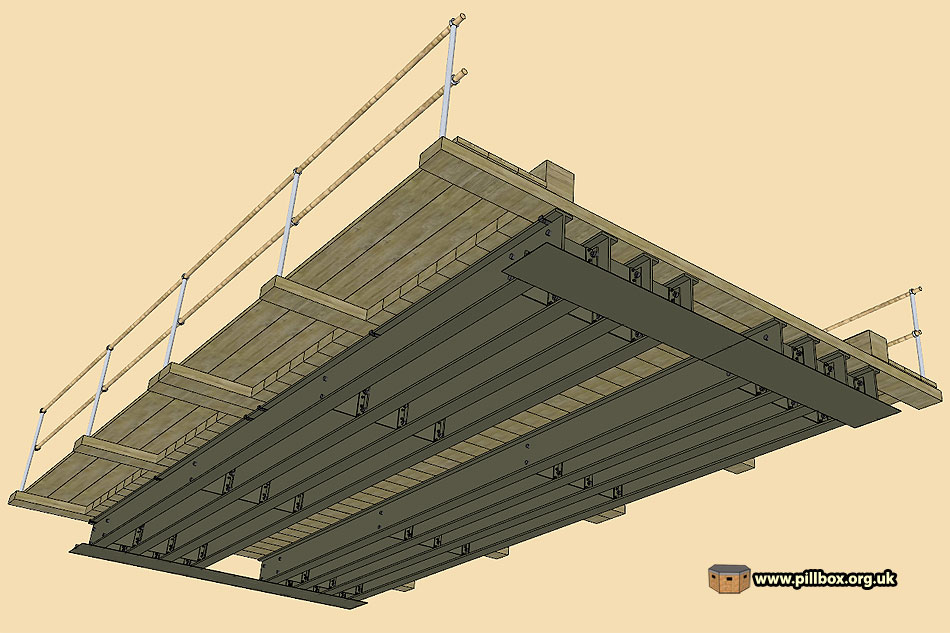
This is all very well, but why invest several hours into reconstructing a relatively obscure bridge? I had never heard of the stock span before; although I knew about various other types of bridge, it's the Bailey Bridge that everyone is aware of.
If you're a regular visitor here, you'll know that I revel in the obscure detail that most people overlook, but also because I found one record of a stock span being erected in East Sussex in a war diary.
I'll reveal all in due course!
- Pete

Email:
Blog Latest

Bishopstone reveals its pillbox secrets
18 October 2021

Pillbox or Observation Post?
10 June 2020

Uncovering the hidden secrets of a pillbox
8 June 2019

Review of 2018
31 December 2018

Wartime Christmas in East Sussex (2)
24 December 2018
Jargon-buster
War diary
A record of events kept by all units from the point of mobilisation. A diary's contents vary enormously from unit to unit; some give detailed entries by the hour on a daily basis while others merely summarise events on a weekly/monthly basis.
This site is copyright © Peter Hibbs 2006 - 2024. All rights reserved.
Hibbs, Peter Digital Meccano - the Stock Span Bridge (2024) Available at: http://pillbox.org.uk/blog/216716/ Accessed: 27 July 2024
The information on this website is intended solely to describe the ongoing research activity of The Defence of East Sussex Project; it is not comprehensive or properly presented. It is therefore NOT suitable as a basis for producing derivative works or surveys!